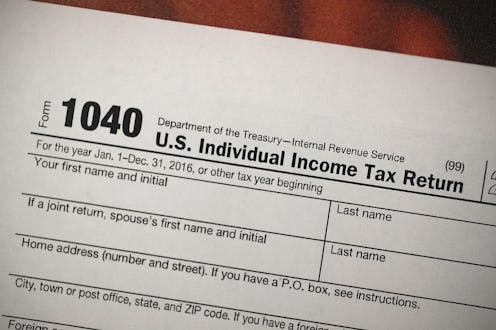News
How To Figure Out Your 2017 Tax Bracket

President Donald Trump signed Republicans' Tax Cuts and Jobs Act just before beginning his Christmas holiday, leaving many scrambling in confusion as they prepare to file their 2017 taxes and evaluate how the bill will affect their 2018 taxes. For instance, how can you learn what tax bracket you fall under for 2017?
Although Republicans' new tax legislation will see a major overhaul roll out in January, most people won't notice the effects of those changes until they go to file their 2018 taxes in the early part of 2019. In fact, while the Tax Cuts and Jobs Act will change almost all of the current tax brackets as of Jan. 1, taxpayers will need to use the now "old brackets" when filing their 2017 taxes.
Until it comes time to file 2018 taxes in April 2019, taxpayers will continue to rely on the "old brackets" when filing their 2017 taxes. According to Fortune, the recently deemed "old brackets" for a single filer are as follows:
- 10 percent for those earning up to $9,525
- 15 percent for those earning between $9,525 and $38,700
- 25 percent for those earning between $38,700 and $93,700
- 28 percent for those earning between $93,700 and $195,450
- 33 percent for those earning between $195,450 and $424,950
- 35 percent for those earning between $424,950 and $426,700
- 39.6 percent for those earning $426,700 or more.
For those married and filing their 2017 taxes jointly the applicable tax brackets will be as follows:
- 10 percent for couples earning up to $19,050
- 15 percent for couples earning between $19,050 and $77,400
- 25 percent for couples earning between $77,400 and $156,150
- 28 percent for couples earning between $156,150 and $237,950
- 33 percent for couples earning between $237,950 and $424,950
- 35 percent for couples earning between $424,950 and $480,050
- 39.6 percent for couples earning $480,050 or more.
Although Republicans kept the seven-bracket system currently in place, they made changes to nearly all of the brackets by tweaking the applicable rates and income levels as part of their sweeping tax overhaul. This means that when it comes time to file your 2018 taxes, you'll use a different series of brackets and income levels than you did this year.
Under Republicans' Tax Cuts and Jobs Act the new tax brackets for taxpayers filing as single are as follows:
- 10 percent for those making up to $9,525
- 12 percent for those making between $9,525 and $38,700
- 22 percent for those making between $38,700 and $82,500
- 24 percent for those making between $82,500 and $157,500
- 32 percent for those making between $157,500 and $200,000
- 35 percent for those making between $200,000 and $500,000
- 37 percent for those making more than $500,000.
For married taxpayers filing jointly, the new tax brackets will be:
- 10 percent for those pulling in up to $19,050;
- 12 percent for couples pulling in anywhere between $19,050 and $77,400
- 22 percent for those with a combined income between $77,400 and $165,000
- 24 percent for those who fall between $165,00 and $315,000
- 32 percent for couples earning anywhere between $315,000 and $400,000
- 35 percent for those earning between $400,000 to $600,000
- 37 percent for those making $600,000 or more.
But while the recently-signed-into-law tax overhaul lowers individual tax rates, these changes aren't designed to be permanent. Rather changes to the tax brackets are set to expire and revert back to the 2017 levels after 2025.
It should also be noted that income levels with each bracket will be adjusted up for inflation each year. However, according to Bloomberg, income levels will likely rise slower under the GOP's tax law than they have previously, meaning that more taxpayers could end up falling victim to what is known as bracket creep by being moved into higher tax brackets sooner. This is because the new law relies on the chained consumer price index rather than traditional CPI, which seeks to adjust income levels for inflation so as to protect people from being pushed into higher brackets as a result of inflation rather than actual increases in their income.
While Republicans' new tax law is set to go into effect in just a few days, it's important to remember that changes to the tax brackets aren't retroactive, meaning you'll want to use the "old brackets" when planning and filing your 2017 taxes.